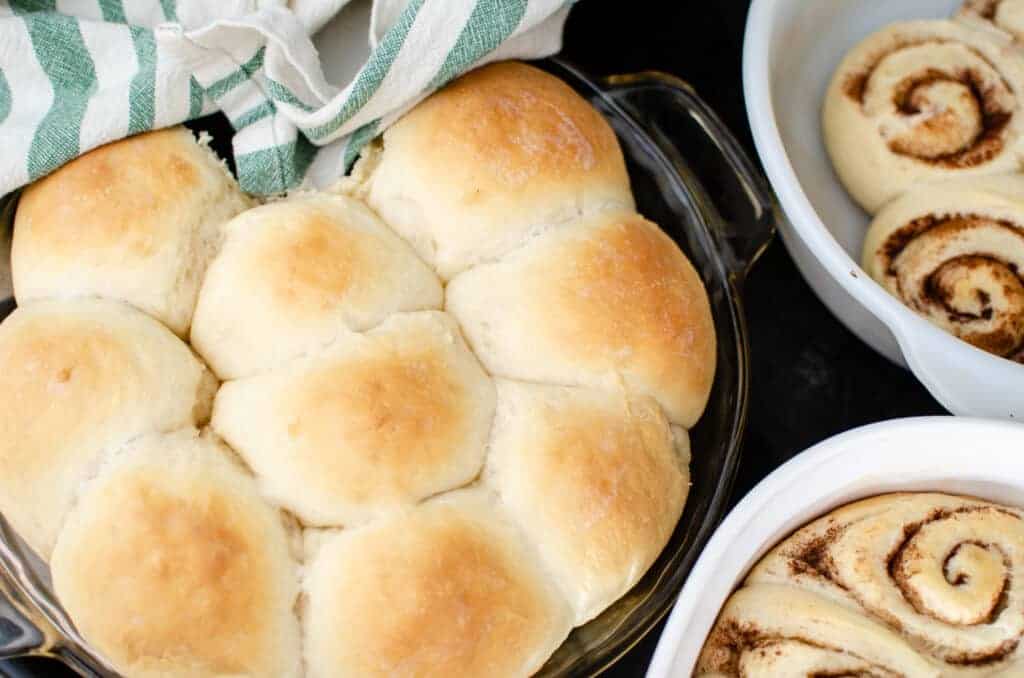
Long-fermented sourdough dinner rolls are a staple in any farmhouse. If you’re looking for a traditional long-fermented sourdough dinner roll recipe, you’ve come to the right place!
These rolls are light and fluffy, and are the true definition of comfort food. This is the way sourdough rolls should taste!
If you’re looking for a simple and quick dinner roll recipe, you can find my everyday one here.
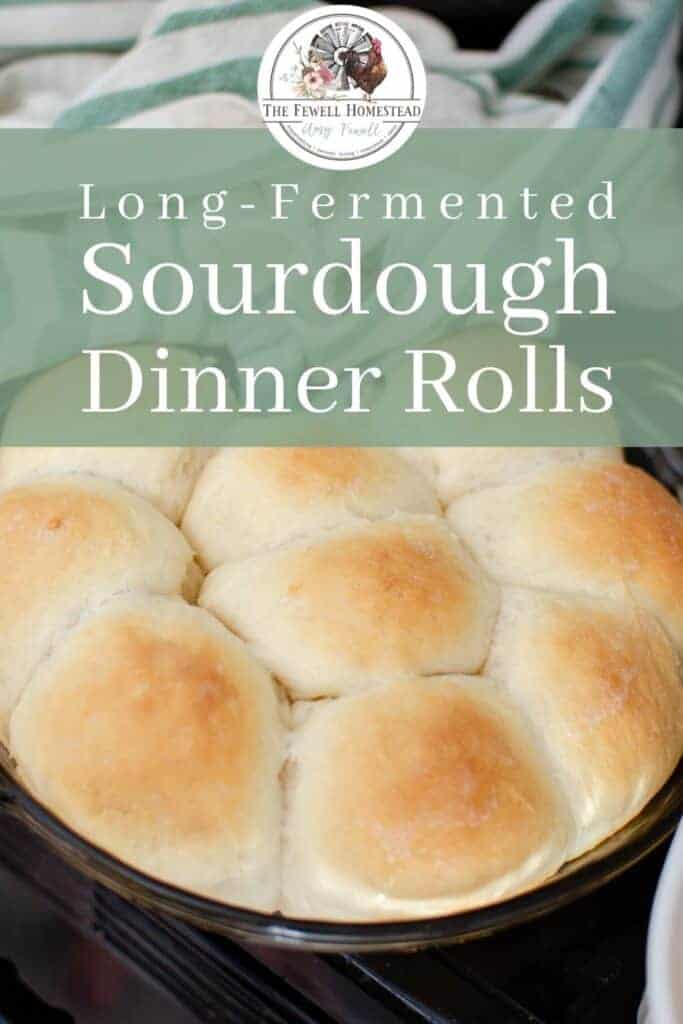
Why Long-Fermented Sourdough?
Traditional sourdough is long-fermented. This means that the sourdough starter actually does all of the work in making the dough rise, without the help of a store bought yeast.
To accomplish this, you have to allow the dough that you make to set and rise for several hours with most recipes. In some recipes, like pancakes or biscuits, you don’t need to let your batter sit for hours. Letting it sit and become active for 30 minutes or so is all that’s needed since there are less grains to ferment.
But with sourdough dinner rolls, or sourdough cinnamon rolls, there’s a lot more flour to ferment. Therefore, it takes a little longer. Thankfully, once the fermenting is done, the grains are easier to digest! And you have an all natural dough without the help of a store bought yeast.
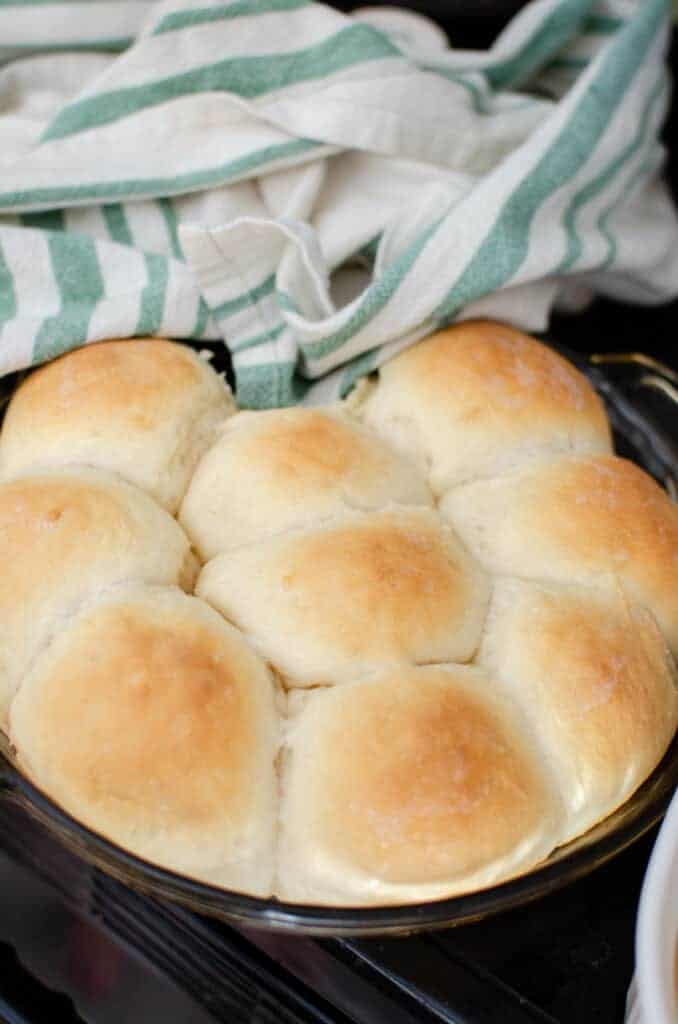
Sourdough Dinner Roll Recipe (Long-Fermented)
1/2 cup butter, softened (salted or unsalted, I prefer salted)
1/3 cup sugar
1.5 cups fed sourdough starter*
2.5 cups milk
5-6 cups flour
- In a stand mixer, cream butter and sugar until mixed together well.
- Add sourdough starter and milk, mix.
- Add 5 cups of all purpose flour. Your dough should be a little sticky, but still firm. You can also knead by hand. If dough is still too sticky, then add up to another cup of flour in half cup increments. Knead until smooth and elastic
- Put dough in a greased bowl and lightly grease top of dough. Let rise for 8 to 12 hours, or overnight. If your living area isn’t warm, it will take longer to rise. But generally it’s doubled in 8 to 12 hours. In a warm home (75 or above), my dough is always ready in 8 hours.
- Once dough has risen, punch down your dough. Pull off large mounds (the size of a walnut husk) and roll into dinner rolls. Place in a greased pan and let rise another 2 hours.
- Bake at 350 for 20 minutes or until golden on top. Butter tops as soon as you take them out of the oven.
* a fed sourdough starter is a starter that was fed in advance a few hours earlier, and is still very bubbly and fermenting.
Other posts you might enjoy:
- How to Make a Sourdough Starter
- Easy Sourdough Bread Recipe
- How to Make Sourdough Biscuits
- Sourdough Cinnamon Rolls (Long-Fermented)
- Traditional Sourdough Pancakes
Find ALL of my sourdough recipes by clicking here.
Sourdough Dinner Roll Recipe (Long-Fermented)
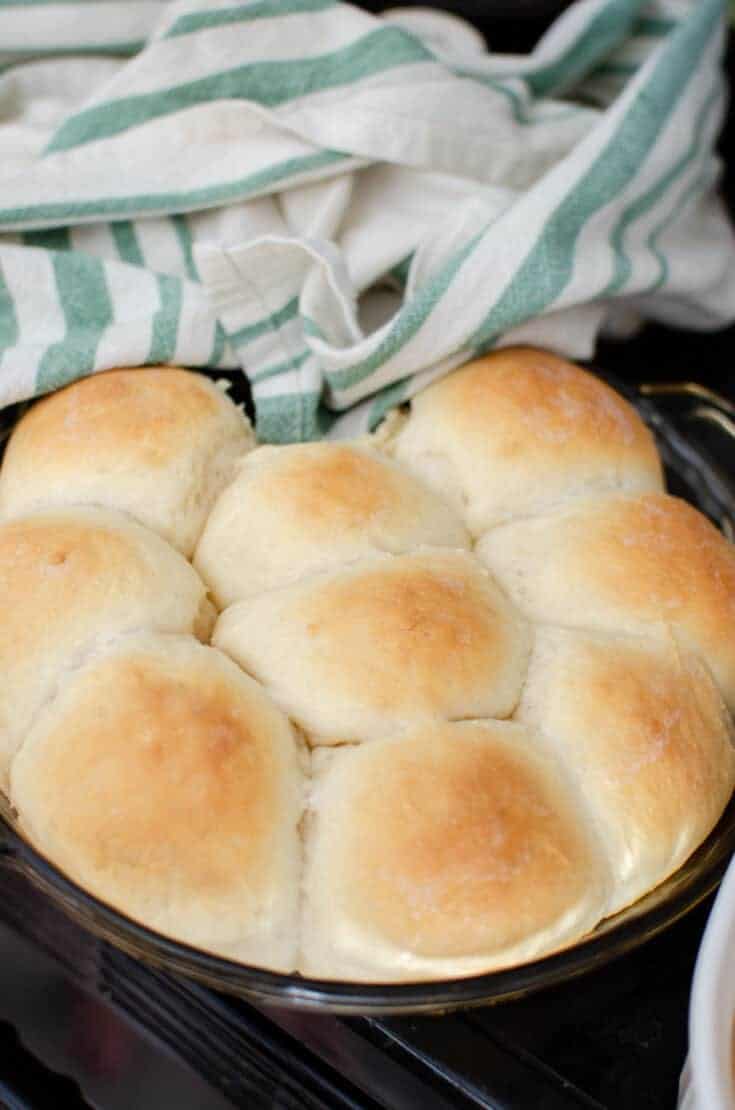
Ingredients
- 1/2 cup butter, softened (salted or unsalted, I prefer salted)
- 1/3 cup sugar
- 1.5 cups fed sourdough starter*
- 2.5 cups milk
- 5-6 cups flour
Instructions
- In a stand mixer, cream butter and sugar until mixed together well.
- Add sourdough starter and milk, mix.
- Add 5 cups of all purpose flour. Your dough should be a little sticky, but still firm. You can also knead by hand. If dough is still too sticky, then add up to another cup of flour in half cup increments. Knead until smooth and elastic
- Put dough in a greased bowl and lightly grease top of dough. Let rise for 8 to 12 hours, or overnight. If your living area isn’t warm, it will take longer to rise. But generally it’s doubled in 8 to 12 hours. In a warm home (75 or above), my dough is always ready in 8 hours.
- Once dough has risen, punch down your dough. Pull off large mounds (the size of a walnut husk) and roll into dinner rolls. Place in a greased pan and let rise another 2 hours.
- Bake at 350 for 20 minutes or until golden on top. Butter tops as soon as you take them out of the oven.
Notes
* a fed sourdough starter is a starter that was fed in advance a few hours earlier, and is still very bubbly and fermenting.
Nutrition Information:
Serving Size:
1 gramsAmount Per Serving: Unsaturated Fat: 0g





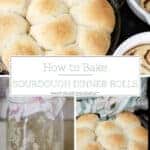
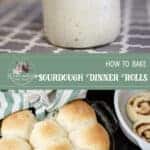
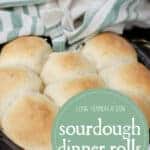



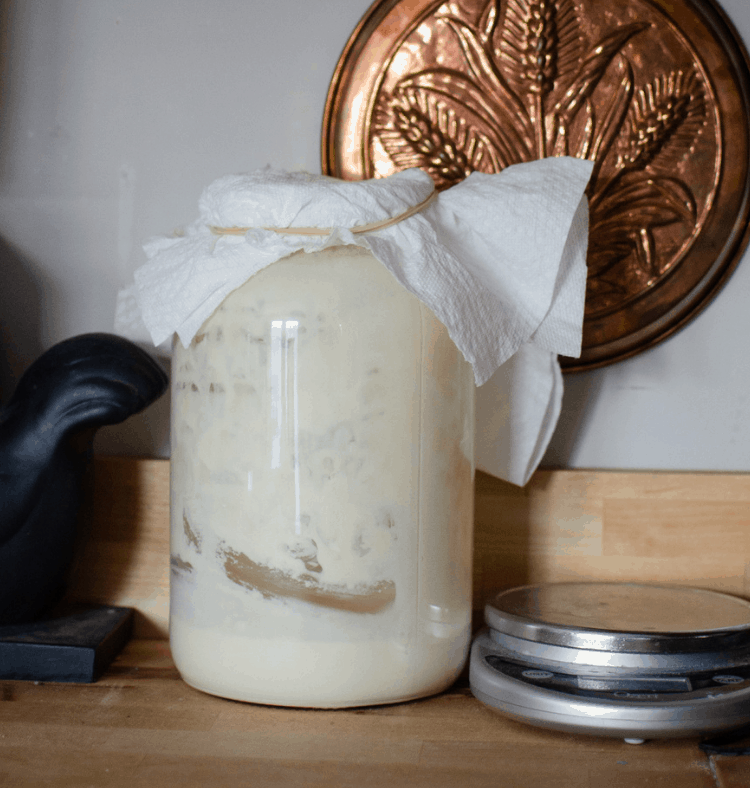
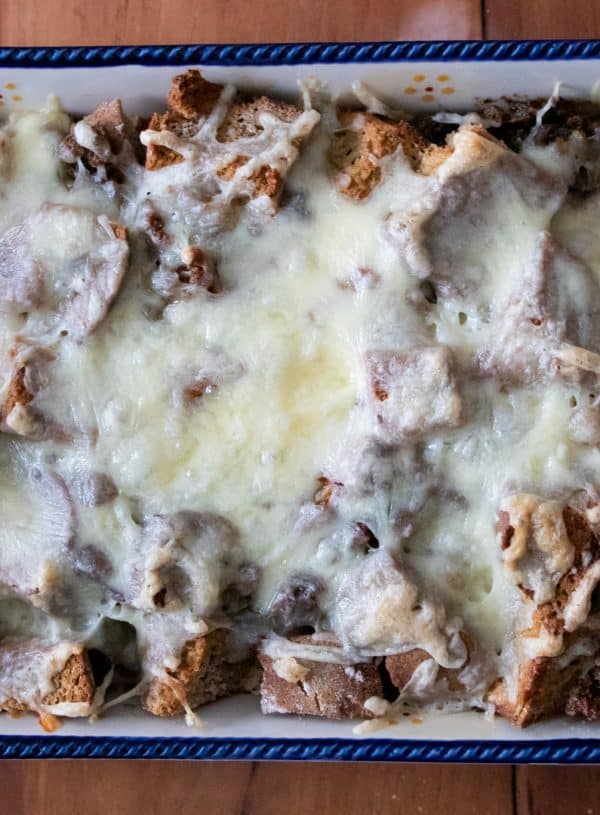
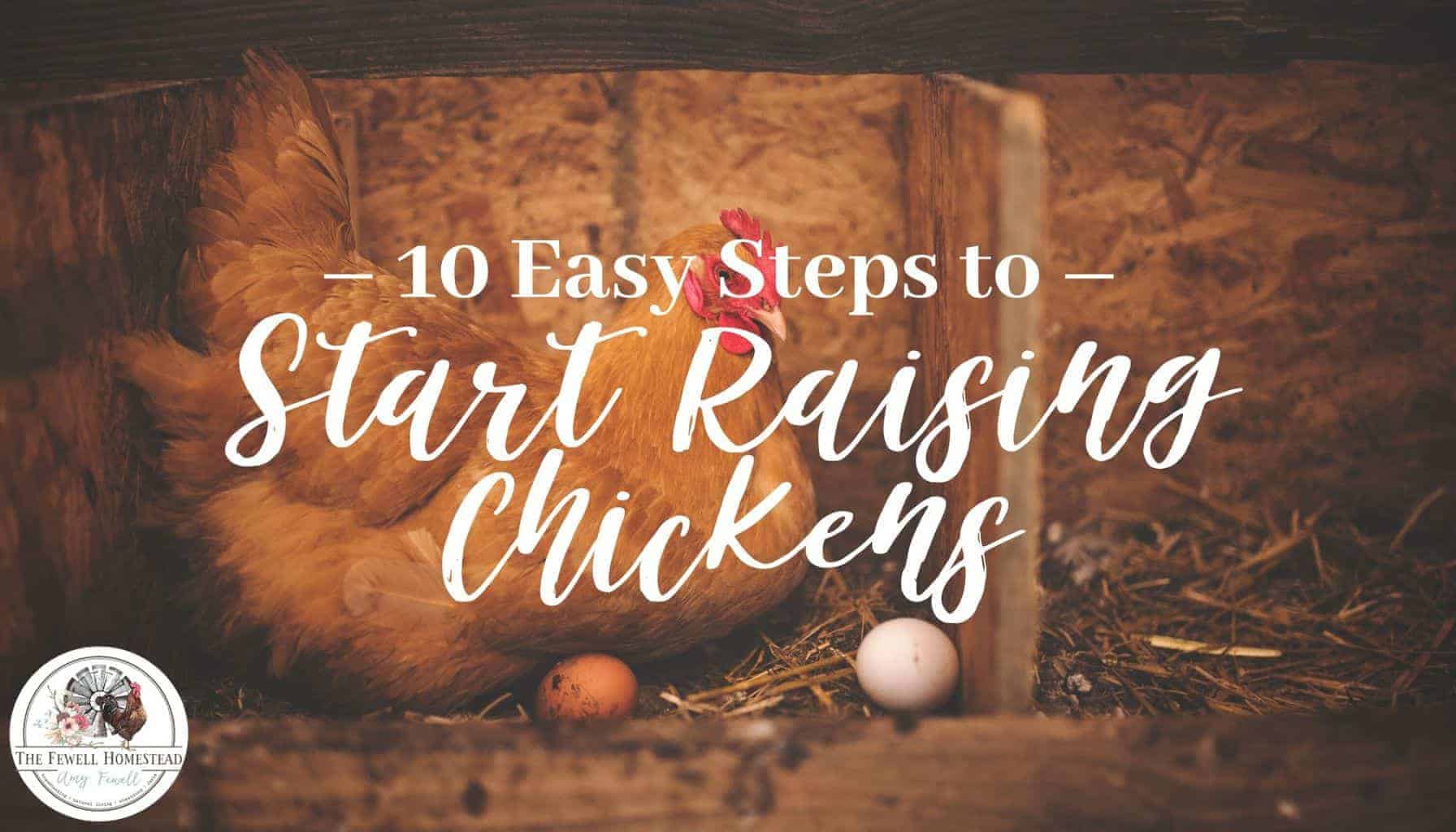
This dough is extremely sticky. I put in five cups of flour and it was a huge mess. I kept adding and it was still a mess. I know after kneading the dough comes together more, but this was so messy it was hard to even knead it. if I make these again, I will probably add a half a cup less liquid from the start. The flavor, it seems, will be very yummy, but I’m worried about the texture after messing with it so much to get it mixed up. Any tips would be great!
Hmmm, I’m not sure what happened there! This dough is a pretty thick dough and not a mess, normally. Though sometimes with sourdough, if it’s raining or there is high humidity, the dough can become more sticky. You may try kneading with a mixer first and then transitioning over to kneading by hand? I’ve always just done it in my stand mixer.
The rolls came out very good! They were super yummy and everyone loved them. Kinda a pain initially but very, very tasty! I think my starter is just high hydration.
I just made these rolls and they are wonderful! Like you, my original dough was a very sticky mess and I ended up using 8 cups of flour. I think the problem is the ratio of liquid to flour…4 c of liquid (4/12 if you count the butter) to 5-6 cups flour is going to be wet!
Hey guys — it could DEFINITELY be your atmosphere and where you live. Sourdough will work different ways if your home is humid, or it is raining outside. I’m able to use what is listed in this recipe without any issues, with a well floured surface. Sourdough can be crazy! But oh so yummy.
Great recipe, but it needs SALT.
In reference to the previous comment, dough was sticky until I added a cup or so of flour.
Instructions about how long to knead would also be helpful. I used a kneading hook and just guessed.
As with most bread recipes, you don’t go by knead time. This recipe says “knead until smooth and elastic”, which is the better way to knead bread, as environmental influences come into play. You probably needed to use more flour because the humidity in your home or location is higher or was higher that day. Some days I have to add an extra cup, other days I had less flour than is in the recipe. It’s all in the consistency with bread, not necessarily the recipe.
Sorry if I missed it but I’m trying to find out about how many rolls this recipe makes. Thanks!
about 20 to 24 rolls
Do you know the weight of the ingredients in grams?
I was so excited to make this recipe! But I do not like baking using measurements, I’m looking for measurements in weight by grams. Do you happen to have that!?
I added 2 teaspooons of salt to the recipe, it made 24 rolls in two 9 by 12 pans. They had to be much larger than walnut size pieces or I would have had 48 mini rolls. 😂. Other than that, these were really good! And I baked them for 10 minutes longer than the recipe called for. Thanks for the recipe!
Walnut husk, not walnut. The husks are closer to the size of small clementines. Like 2.5 inch diameter.
Hi Amy,
If I make these in advance can I put them in the refrigerator or something? Obviously fresh is best, but if I’m planning on using half the dough for cinnamon rolls and the other for these dinner rolls, the CR will go in for breakfast and then I’ll have a few hours to preserve these before dinner. Thanks!
Has anyone made these in advance and put them in the freezer? If so, is it before baking, after baking or short baking before freezing?
BTW . . . .
Altitude affects the amount of flour I use in SD recipes. Greatly.
Thanks.
Needed for sure a full seven cups of flour and I wish I had added salt too (I used salted butter but it was not enough salt). I had to knead by hand and it took like an hour before the dough almost passed the window pane test but I think this is down to me as an inexperienced bread baker. Like another commenter I also did more like clementine-sized chunks for the buns and I did get 24 rolls going by that size.
My starter was very active after I’d been feeding it twice a day for five days, and the dough just about doubled in 8 hours in my oven with the oven light on (maybe ~77-80 degrees F). I needed it to ferment longer for digestive reasons so stuck it in the fridge overnight. After shaping the buns the next morning it took about 2.5 hours for them to rise again. All good to me, just want others to know what they might expect.
The texture of these buns is excellent, if a bit close (my fault for the super long rise). They definitely, definitely need salt. But they’re exactly what I wanted out of this recipe! Thank you, I’ll likely be making again with the modifications I noted and trying to time it better so they don’t over-rise but still ferment long enough for digestive gentleness.